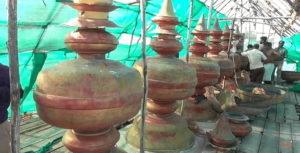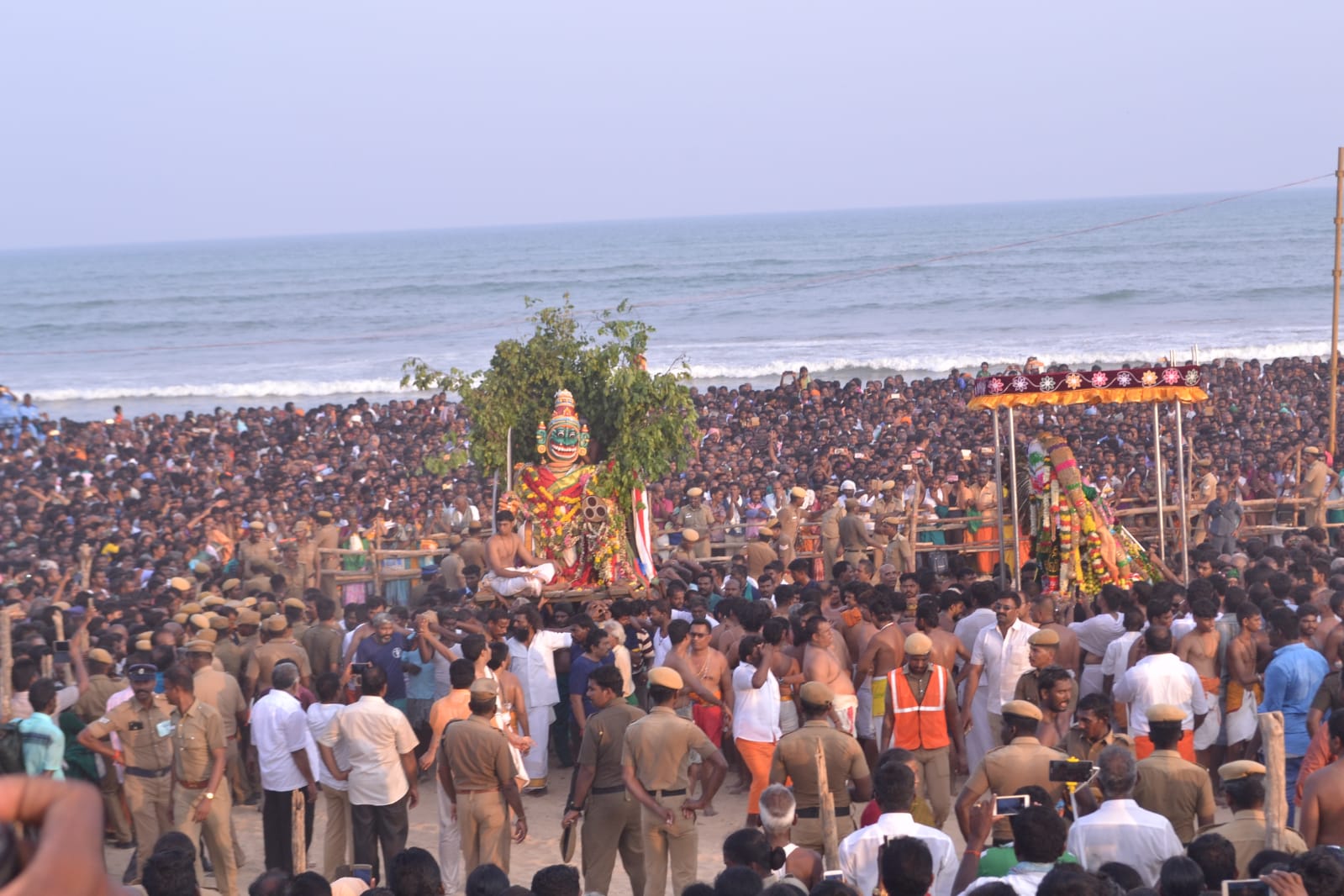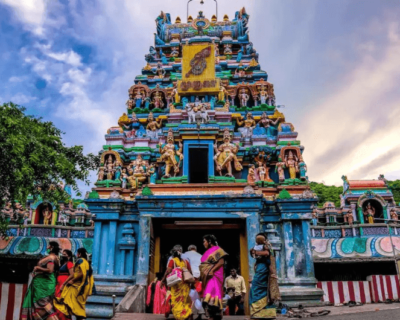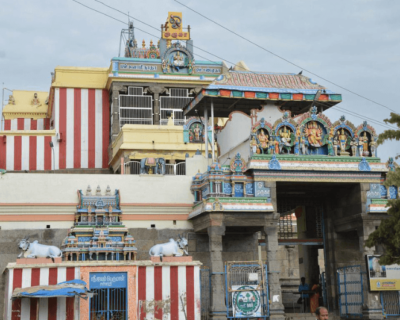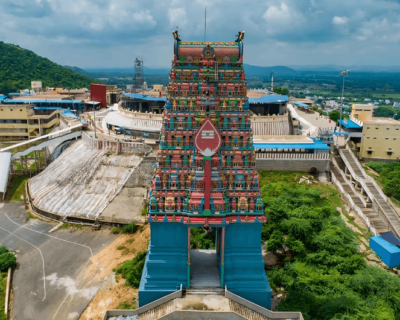Thiruchendur Murugan Temple
Thiruchendur Thirukoil is the Second place of Arupadai veedu. This sacred house of god is in the extreme southwest of the Indian Peninsula. It is located at the shore of the Bay of Bengal. The young Lord Muruga as the Devasenathapathy vanquishes Evil in the forms of Surapathma. The Tamils have ever since been celebrating the as an annual festival during Skanda Shasti. Lord Muruga is referred to as Seayon in the ancient literature. Mentioned in the Sangha literature and Silapathikaram, this temple is believed to be 2000-3000 years old.
This is a beachside temple dedicated to Lord Muruga. The place where this temple is located was earlier known as Thirchiralaiwai. The tower of the temple is 157 feet height with nine floors. After conquering Soorapadman, Lord Muruga performed Shiva Puja to express his gratitude for his victory. Here Murugan graces with a lotus flower on his right hand. He also wears a Jadamakutam on his head like Shiva Yogi.
Rajagopuram is located in the west direction of Murugan shrine in Tiruchendur. Lord Muruga looks towards the east in this temple looking at the sea. The main Gopuram was constructed behind the Swami, (i.e. in the eastern direction) But the tower is built in the west because of the sea in the area. West Raja Gopuram gate is opened only for one day a year at midnight during Murugan Thirukalyanam during the Kandashashti festival. Devotees are not allowed to enter at that time. During the six-day Kandashashti festival, devotees fast and worship Lord Muruga.
Thiruchendur Murugan Temple History
The Seashore temple of Subramanya Swamy at Tiruchendur is one of the delightful spots sanctified and venerated by every Hindu. This sacred house of God is in the extreme southwest of the Indian peninsula. The nucleus of the structure however has been here for more than 2,000 years as the Tamil Classics. In devotional literature however, and in the Thirumurugatruppadai, an earliest account of his worship, six chosen spots in the Tamil land are referred to by Nakkirar as of more than ordinary sanctity for his worship, and thereby favoured by him. Tiruchendur occupies among them the second place in importance. Uncommonly enough, this Temple is located on the seashore, while the rest of his temples are invariably located on high elevations as on hilltops.
The Pandya and the Chera, their generation, and other men of devotion further improved the temple. Maharaja Marthandavarma, the maker of modern Travancore, endowed the very first the UdayaMarthanda kattalai of each morning, more than two centuries ago and others followed in the nine arathanas of the day. As time rolled on, the effect of the sea and its salt-laden air began to corrode upon the inferior sandstones used at the first instance in the original construction. It was now that a noble Sanyasin, Mouna Swami saw the stones in a state of disintegration. He almost immediately took up the renovation and was followed by two others (Kasi Swamigal, and Arumuga Swamigal). The work continued during the course of 72 years, and this noble edifice of three prakaras was reconstructed new, in imperishable black granite, discarding every bit of the original white sandstone structure.
The Sanyasins were wedded to poverty, but nevertheless funds were awarded in to fulfil their life mission of constructing a worthy Temple (House of God) to stand for all times. The temple was fully constructed a new in all its details, and Kumbabisheka performed in 1941 for West Gopuram having nine floors, built on the extremity of the sandstone cliff are a landmark, and visible at sea for twelve miles around, looking as a brig in full sail.
Thiruchendur Kumbabishekam Date 2025
For the comfort of the devotees in this temple, which is located along the scenic beach, extensive works with various structural facilities are being carried out from the year 2022 with a fund of Rs. 300 crores. And the restoration work is going on in full swing. As a part of it, Balalayam was conducted for the East Gopuram of the temple and Shanmukha Vilasa Mandapa Gopuram on 16th February 2023 and in the 2nd phase for Rajagopuram on 26th April.
At this stage, the Rajapura restoration work has started and is going on vigorously with an estimate of Rs.16 crores. The 137 feet high, 9-tiered, 9 kalashas Rajagopuram is undergoing complete renovation and renovation of the lower floors and pillars of the Rajagopuram. At this stage, the 9 caskets on the top of the Rajagopuram have been worshipped according to the rules of Agama, separated separately and brought down and the renovation work has started now.
The old line in 9 urns was replaced. Charity officials and devotees were ecstatic and amazed to see that the wealth inside the casket remained unchanged. It is significant that after 15 years, Kumbabhishekam will be held next year 2025 but the exact date has been announced July 7th.
Mythological History
Tiruchendur means a sacred and prosperous town of victory. The place has been known variously as TiruCheeralaivai, Thiruchendhil and Tiruchendiloor in the Tamil Classics, Jeyanthipuram and Sindhupuram in Sanskrit texts, Tiribhuvana madhevi chadhurvadhimangalam in the Later Pandya Inscriptions, and Tiruchendur from the 16th century as popularly mentioned in Thiruppugazh. Thiruchendur figures as the second of the six favourite abodes of Muruga as described by Nakkirar in Tirumurugatruppadai. The poem is of great devotional and literary merit and sung by devotees in their daily devotions.
Saint Arunagiris’s stanzas of Tiruppugazh are sung in praise of Tiruchendur. This staunch bhakta of Muruga had worshipped his favourite Lord at this famous shrine and mentioned his passionate lyrics of praise in his versest reveal his attachment and the grace he forecasts to those who sincerely believe in Him. Another classic of the Lord of Tiruchendur is Kandhar Kalivenba by Kumaragurupara Swamigal, a Saiva ascetic. The author was born at Srivaikuntam nineteen miles from Tiruchendur. His parents were blessed with this child after a long penance to Muruga of Tiruchendur. The boy grew of age and until his fifth year showed no signs of speech. The parents were pained at this and resorted to Tiruchendur for penance again.
Weary of waiting for months and seeing no signs of approaching speech, the parents determined to drown themselves in the sea along with the child if he would not speak by a particular day: The day dawned, and yet there were no signs. At last, both the parents and the child entered the foamy waves. Deeper and deeper they went from knee to neck, and, as they were about to sink with the waves over their heads a human form appeared with a flower in his hand and asked the child what it was when the child broke out in praise of the Lord with the words of the lines. Kanthar Kalivenba of 244 lines is a delightful piece of the Lord’s praise and the truths of Saiva Siddhanta.
And, it is considered even now with great propriety that its recitation with warmth and fervour wards off many an evil attending on man. The arulprasatham issued in this temple is known as Leaf prasadham. The three sadhu swamigal completed the temple thirupani and three prakaram by this leaf viboothi. Moreover, it cured the stomach pain of Templehi Sankarar, who wrote the Thiruchendur Subramaniya bhujangam. This place is known as Thirucheeralaivai, later it called as Thiruchendur
Mythological Background
It was ascertained from Vedha, that two groups of munies. One of them is known as Devar and the other one is Asurar. The Asurar group make so many troubles against Devas. The main Asurar giving troubles to devas was known as Soorapathma Hence the devar pray Lord Shiva to annihilate Soorapathma. Lord Siva accept the prayer of devas. It was believed that, the Lord Murugan was born out of the six sparks that, emanated from the third eye of Lord Siva.
Then Lord Siva ordered Lord Muruga to annihilate Soorapathma, After accepting the order of Lord Shiva, Muruga came to Tiruchendur to annihilate Soorapathma. At that time the Guru of Devar known as Vizhayabhavan, Continued in thavam for the darshan of Lord Muruga. After giving darshan to Vizhlayabhavan Lord Muruga halted in Thiruchendur. He knows the Asurar history from Vizhlayabhavan. Then Lord Muruga sent his Defence Chief Veerabagu to Soorapathuma as a messenger and requested to end the trouble given by him to devas. Soorapathma does not accept the request made by Lord Muruga to make peace. Finally, Lord Muruga annihilated Soorapathma with the help of his defence. After that incident, the Vizhalayabhavan made a request to Lord Muruga to halt in Thiruchendur, being the memory of his darshan. Then Vizhalayabhavan constructs this temple under the guidance of Vishvakarma. Due to the victory of Muruga in Annihilating Soorapathma. Lord Muruga was called as Jayanthinathar In the late this name was known as Senthilnathan and this place was known as Jayanthipuram. (Jayanthi – Victory) Later called Thiruchendur.
Valli Cave
Lord Vinayaga who is the Elder brother of Lord Muruga, takes the form of an elephant and chases Valli to reunite him with his younger brother. Valliammai was afraid of him and hid in the cave. That scene is realistically distilled here and we are witnessing it. Valliyammai appears in this Sannithi as the mother who removes the marriage bar of women born and gives marriage and all healthy life. She is a motherly Ambal who bestows the blessing of children on those who do not have child wealth
Pancha Lingam
The Pancha lingam is placed behind the Moolavar to be worshipped through a small gate. Five lingams are located on the same plinth, so they are called Pancha Lingam. These lingams are believed to be worshipped by Lord Muruga himself.
Temple Amenities
Marriage Hall:
- Temple-managed Kalyana Mandapams available inside or near temple premises with multiple hall.
-
Govindammal Athittanar Hall – ₹1,150/day.
-
Singapore Govindaswamipillai Kalai Arangam – ₹1,050/day.
-
Sashti Virutha Mandapam (Idumban Shrine) – ₹5/day (up to 75 people).
Tonsure Facility
-
Dedicated tonsure shed available, capable of accommodating about 200 devotees at a time.
-
Tonsuring is free — devotees simply wait in line and receive a token. (As per recent development in other Murugan temples.)
Vehicle Parking
-
Multiple designated parking zones set up throughout the town, handling large volumes—during the July 7 Kumbabishekam, over 30,000 vehicles and 20,000 buses were accommodated across 18 temporary parking areas.
-
On daily visits, temple-adjacent roadside parking is common, though space fills up quickly, especially on Tuesdays, Thursdays, and weekends.
-
Informal parking fees may be collected by locals—typically ₹20–₹50 per car.
Information Centre
Temple staff and volunteers near the entrance help with:
-
Inquire about darshan timings, puja schedules, and festivals.
-
Book rooms or marriage halls, as per temple services.
-
Temple Office Contact:
-
Phone: 04639‑242221
-
For information and bookings: 04639‑242271
-
Thiruchendur Murugan Temple Poojai
| Pooja Name | Pooja Timings |
| Thirukkappu (Santhana kappu Alangaram) | 04:00 AM to 05:00 AM |
| Subrabhadham Pooja (Santhana kaappu Alangaram) | 05:10 AM to 05:25 AM |
| Viswaroopa Pooja (Santhana kaappu Alangaram) | 05:30 AM to 05:35 AM |
| Kalasandhi pooja (Thanga kavasam) | 08:00 AM to 08:30 AM |
| Uchikkala Pooja (Thanga kavasam) | 12:00 PM to 12:15 PM |
| Sayaraksha Pooja (Thanga Kavasam) | 05:00 PM to 05:15 PM |
| Palliyarai Pooja (Santhana kaappu Alangaram) | 08:45 PM to 09:00 PM |
| Thirukkappu (Santhana kaappu Alangaram) | 09:00 PM to 09:05 PM |
Thiruchendur Murugan Temple Archanai & Other Fees
| Fees Description | Fees |
| Maniyadi viraivu dharisanam | 100 |
| Abishekam | 1500 |
| Golden Car | 2500 |
| Shanmugar Archanai | 5000 |
Thiruchendur Murugan Temple 2025 Festivals
| Festival | Date (2025) | Significance |
|---|---|---|
| Panguni Uthiram | April 11, 2025 | Celebrates Murugan’s celestial marriage; involves special poojas & kavadi. |
| Vaikasi Visakam | June 9, 2025 | Lord Murugan’s birth star; 10-day spring festival, chariot processions, kavadi offerings. |
| Avani Festival (Aavani Therottam) | August 13–25, 2025 | 12-day festival featuring Silappu Sathi, Pachai Sathi, and grand car festival. |
| Skanda Sashti (Soorasamharam) | October 22–27, 2025 | Six-day fasting ritual culminating in Soorasamharam deity reenactment. |
| Kumbabishekam (Consecration) | July 7, 2025 | Major temple reconsecration after 12 years; 6:15–6:50 AM ceremonies. |
| Monthly Krithigai & Sashti Puja | Every month (Krithigai/Sashti star) | Regular special poojas for Murugan. |



